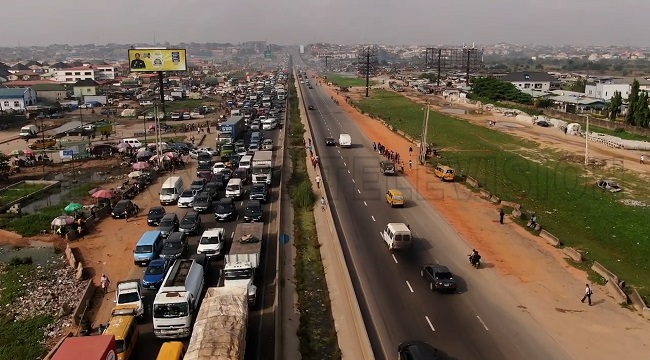By Jeremiah Aminu
The Lagos-Ibadan Expressway, commissioned in August 1978 under the Murtala-Obasanjo military regime, connects Lagos to Ibadan, the capital of Oyo State. The expressway, popularly described as Nigeria’s oldest dual carriageway, is divided into two sections. The first stretch, 43.6 kilometres long, runs from Lagos to the Sagamu Interchange. The second stretch, 84 kilometres long, links the Sagamu Interchange to Ibadan.
Importance of the Lagos-Ibadan Expressway
The expressway has spurred the development of industrial hubs and commercial centres in communities along its route, such as Sagamu, Mowe, and Ibafo, attracting businesses and creating job opportunities. According to The Punch newspaper in 2022, the highway serves as “the gateway to Lagos that accounts for 55 per cent of formal employment, 65 per cent of industry, and most of the country’s maritime trade.” It also functions as a major interconnecting route, linking the Northern, Southern, and Eastern regions of Nigeria. To the north, from Ibadan, the expressway connects to Ilorin and Minna, eventually reaching the border with Niger at Birnin Konni. To the east, the expressway merges with other routes at the Sagamu Interchange, providing access to the eastern and Niger Delta regions and connecting to major cities such as Benin, Warri, and Port Harcourt.
Tragedies on the “Horror Way”
Despite its importance to the Nigerian economy, the expressway has long suffered from severe infrastructural deficiencies, leading to unbearable traffic congestion and frequent accidents. Many observers have also argued that successive governments have used the expressway as a political tool to win votes in what critics describe as the government’s game of “politricks.” During election campaigns, administrations often promise to rehabilitate the road once in power.
Ebun-Olu Adegboruwa, writing in the Nigerian Tribune, cited instances of politicians and political parties using the road as political leverage to secure voters’ loyalty in his piece “The Mysteries of Lagos-Ibadan Expressway.” For example, under Goodluck Jonathan’s administration, a ₦167 billion reconstruction contract was awarded in 2013 to Julius Berger PLC and Reynolds Construction Company (RCC) after an earlier ₦112 billion contract awarded to Bi-Courtney Limited under Yar’Adua in 2009 was terminated in 2012 for alleged professional irresponsibility. The Chairman of Bi-Courtney, Wale Babalakin, rejected these allegations, stating: “If the ill-advised move that led Jonathan’s administration to interfere with the Lagos-Ibadan road project had not happened, the road would have been completed on or before 2014.”
Jonathan’s decision to resume the project in 2013 after terminating the earlier contract in 2012 sparked speculation that his actions were aimed at boosting his political image ahead of the 2015 general election. Similarly, the All Progressives Congress (APC) continued reconstruction works on the expressway “to retain voters’ loyalty,” according to Adegboruwa.
Read Also:
Boxing Day tragedy: 2 die, 15 injured in Lagos-Ibadan expressway accident
Hit-and-run driver kills 2 on Lagos-Ibadan Expressway, flees
Lagos govt to host summit to combat illegal dredging
Yet, despite countless promises by different governments, the road continues to suffer from accidents, cracks, deformations, potholes, heavy traffic, and poor drainage. It was for this reason that Fred Ohwahwa of Premium Times branded the road “The Lagos-Ibadan Horror Way,” highlighting the infrastructural decay and the casualties it causes. Adegboruwa cited tragic cases, including the death of eight friends in September 2018 when their vehicle collided with another car. In 2003, Chief Rufus Foluso Giwa, a prominent industrialist, also lost his life when his driver swerved to avoid a pothole, causing his Lexus SUV to crash and roll over multiple times. Giwa died instantly, although his driver and escort survived.
Amid this persistent crisis, reconstruction resumed once more in 2025. According to a BNC report on August 13, 2025, the ongoing project focuses on Phase 2 of the Lagos-Ibadan Expressway, covering the Sagamu Interchange to Ojoo in Ibadan. The project is divided into two sections:
- Section I (Lagos-Sagamu route): This includes the Ogun River, Marlboro underpass, Wawa underpass, Arepo underpass, Sagamu-Iperu (24 km), RCC Church Interchange, two flyovers, and five pedestrian bridges.
- Section II (Iperu–Ijebu Ode, along the Sagamu-Ore route): Covering 48 km, this section is designed to improve connectivity in the southwest.
The reconstruction aims to enhance road safety, ease traffic congestion, and facilitate efficient passenger and cargo transport.
This raises important questions: Will the current reconstruction finally deliver lasting improvements and address the persistent challenges faced by Nigerians on this vital highway? Or will it turn out to be yet another political manoeuvre or another “politrickal” agenda, that fails to meet expectations, leaving Nigerians to endure the continuing horrors of the so-called “Lagos-Ibadan Horror Way”?



